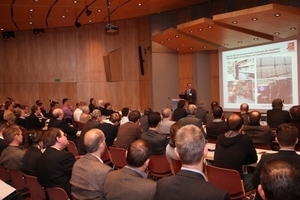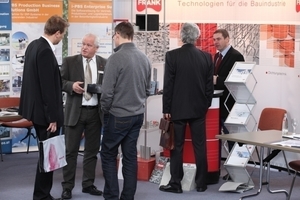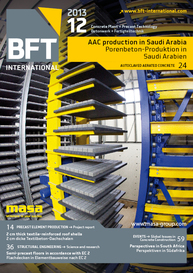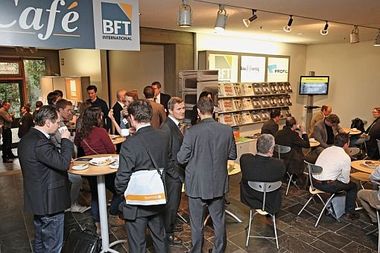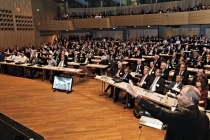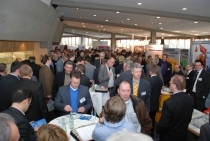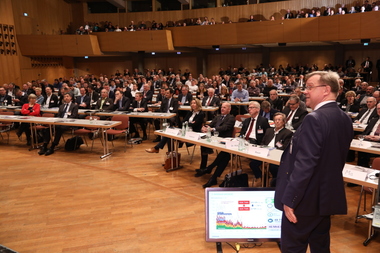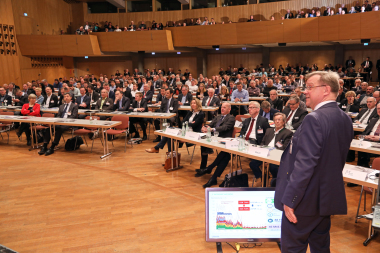Smart concretes: Prospects for the building material
On 18 February 2014, the 58th edition of the BetonTage congress will commence. Representatives of the precast industry will meet in Neu-Ulm to focus on “Smart Concretes”. At the Edwin-Scharff-Haus congress center, a three-day technical program, 13 product-specific panels, about 90 speakers and 160 exhibitors from the supplier, engineering and software industries will provide many new insights to congress attendees. The range of topics covered by the individual presentations addresses all relevant segments of precast. As the guest country invited to the 2014 congress, Austria will widen the perspective beyond the German market.
Panel 1, Application-Oriented Research for Concrete, will focus on innovations in the field of concrete technology. Alternative concrete additives, novel composite materials and formwork designs are but a few of the new advancements to be presented during this panel. Panel 5 will provide comprehensive information on future prospects for concrete in the context of power generation and climate protection, such as for parabolic UHPC troughs for solar power plants or thermally activated concrete components.
Structural precast elements for building construction
Structural precast is one of the cornerstones of the technical program of the BetonTage congress. Panel 3, Structural Precast 1, will showcase selected construction projects to demonstrate the performance and wide range of possible uses of structural concrete components. Furthermore, the draft revision of the DIN 4102-4 standard on the “Fire Behavior of Building Materials and Building Components” will be presented, as well as the new environmental product declarations for concrete.
Panel 6, Structural Precast 2, will deal with innovative technical solutions, including optimization opportunities for floor systems. In addition, this panel will feature an Austrian research project on the use of extremely lightweight precast elements in bridge construction.
Panel 7, Lightweight Concrete, will concentrate on current developments with respect to products and standardization, including the draft DIN 4213 standard, the EC6 stan-dard for masonry, and lightweight architectural concrete.
Panel 8 on cast stone will provide information about the design and engineering challenges associated with the use of cast stone products in interiors and outdoor environments. Among other topics, this panel will deal with the unwanted interactions between black iron oxide pigment and PCE-based superplasticizers that occur in the production of black architectural concrete. This panel will also cover the new DIN 18516 standard for façades and the corresponding ZDB Code of Practice.
New momentum for civil engineering
Panel 2 is dedicated to road construction, gardening and landscaping. Among other aspects, this panel will report on initial experience gained in applying the SLG guideline to implement the Construction Products Regulation and on the provision of performance declarations on the web-based DoPCAP platform.
Panel 11 on pipeline construction and sewage technology is geared towards manufacturers and the public sector. It will include presentations on current standardization issues and the new DWA-A 157 Worksheet, but also hands-on reports from businesses, for instance on their experience in the use of UHPC and concrete-plastic composite pipes.
Continuing training for market partners
The third congress day − the “Market Partners’ Day” − will feature specific panels for architects, engineers, construction contractors and the public sector. Panel 9, Construction Design and Execution, will deal with the use of micro-reinforced high-performance concrete for the reconstruction of existing buildings whilst also referring to the effects of urban resource planning on the design and maintenance of parking facilities.
Panel 10, Concrete in Structural Engineering, will refer to the issue of waterproof concrete basements and demonstrate how a more efficient design can be enabled by appropriate classifications. Furthermore, worked examples will illustrate the effect of integrated building services on the shear resistance of precast floors. Panels 9 and 10 will be preceded by presentations on the reconstruction and refurbishment of existing buildings.
Focus on law
Panel 11, Small Wastewater Treatment Plants, addresses municipalities and, more specifically, representatives of local water authorities and private-sector water management experts.
Legal issues will be dealt with not only in the context of cases of damage to be presented during the individual panels but also in Panel 4, Business and Law.
Please visit //www.betontage" target="_blank" >www.betontage:www.betontage.
de for the complete program.

